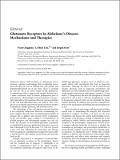Glutamate Receptors in Alzheimer’s Disease: Mechanisms and Therapies
Author(s)
Anggono, Victor; Tsai, Li-Huei; Gotz, Jurgen
DownloadNP.2016.8256196.pdf (423.6Kb)
PUBLISHER_CC
Publisher with Creative Commons License
Creative Commons Attribution
Terms of use
Metadata
Show full item recordAbstract
Alzheimer’s disease (AD) manifests as a progressive loss in memory, cognition, and language that is commonly associated with elevated levels of amyloid-beta (Aβ) peptide and hyperphosphorylated tau in the brain. There is currently no cure for AD as its causes remain poorly understood. Accumulating evidence suggests that synaptic dysfunction is a major contributor early in disease pathogenesis prior to neuronal loss. Glutamatergic neurotransmission is particularly vulnerable to the neurotoxic effects of various assemblies of Aβ and hyperphosphorylated tau. Indeed, these toxic species act in synergy and severely disrupt excitatory synaptic transmission, synaptic plasticity, and network activity.
Date issued
2016-04Department
Massachusetts Institute of Technology. Department of Brain and Cognitive Sciences; Picower Institute for Learning and MemoryJournal
Neural Plasticity
Publisher
Hindawi Publishing Corporation
Citation
Victor Anggono, Li-Huei Tsai, and Jürgen Götz, “Glutamate Receptors in Alzheimer’s Disease: Mechanisms and Therapies,” Neural Plasticity, vol. 2016, Article ID 8256196, 2 pages, 2016.
Version: Final published version
ISSN
0792-8483
1687-5443